#mitsukuni defying the skeleton spectre invoked by princess takiyasha
Explore tagged Tumblr posts
Text

Japanese Yōkai (Supernatural Creatures)
Gashadokuro (Starving/Huge Skeletons)
Mitsukuni Defying the Skeleton Spectre Invoked by Princess Takiyasha, by Utagawa Kuniyoshi via The Honolulu Museum of Art [Archived]
#utagawa kuniyoshi#artist#art#the honolulu museum of art#japanese yokai#supernatural creatures#gashadokuro#starving/huge skeletons#mitsukuni defying the skeleton spectre invoked by princess takiyasha#culture
1 note
·
View note
Text
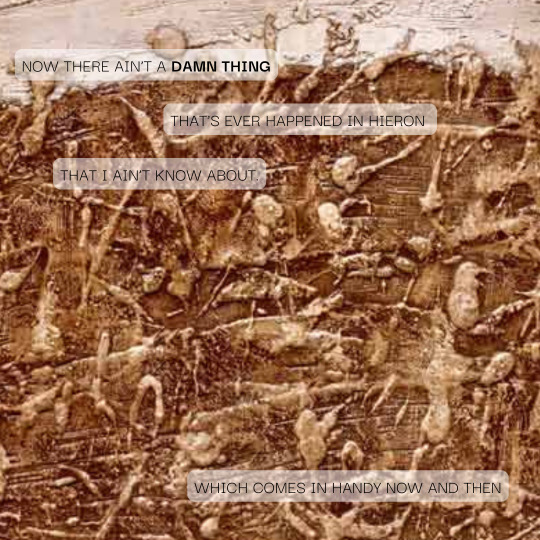
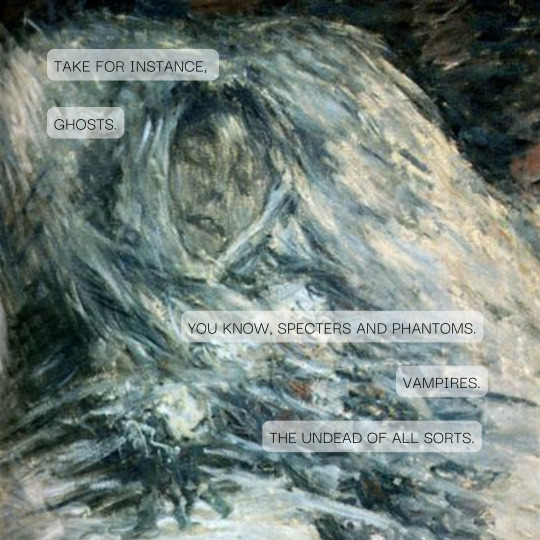
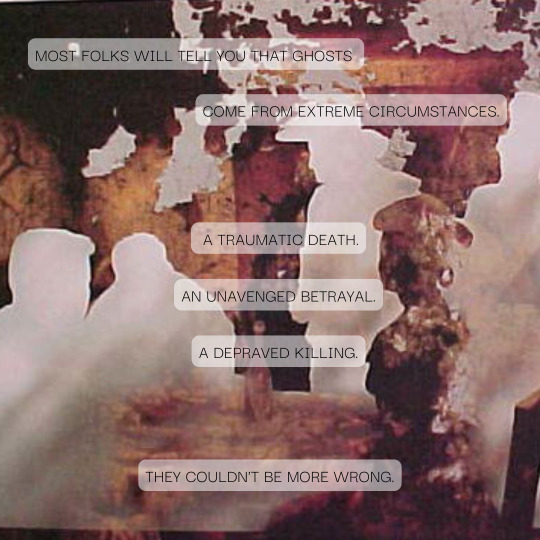
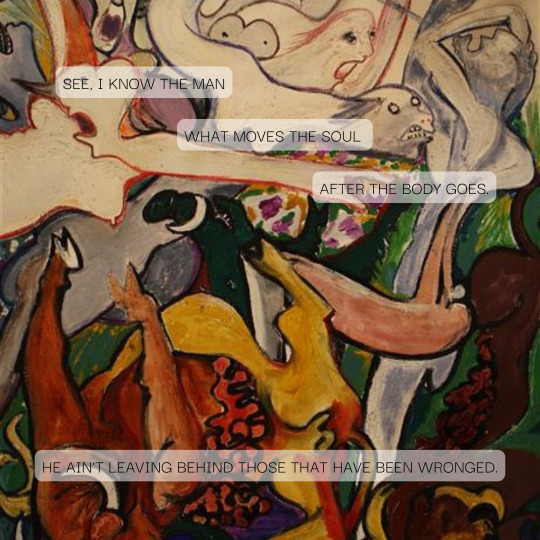

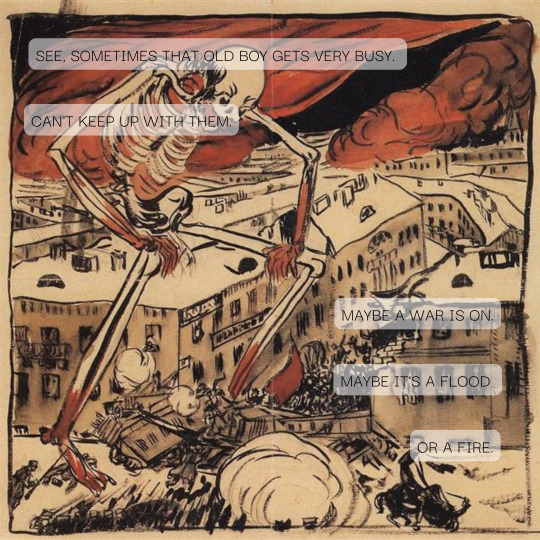
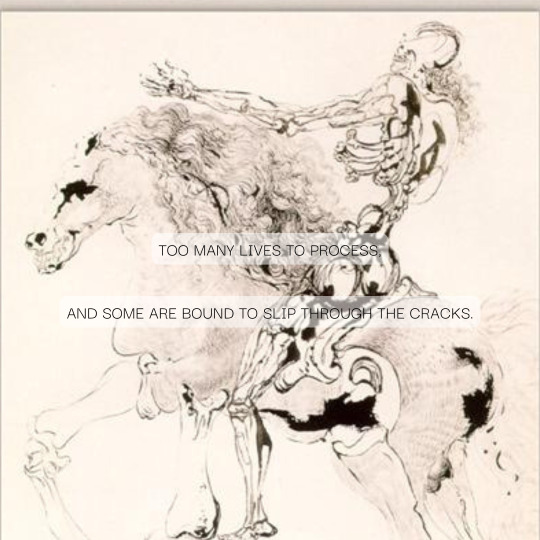

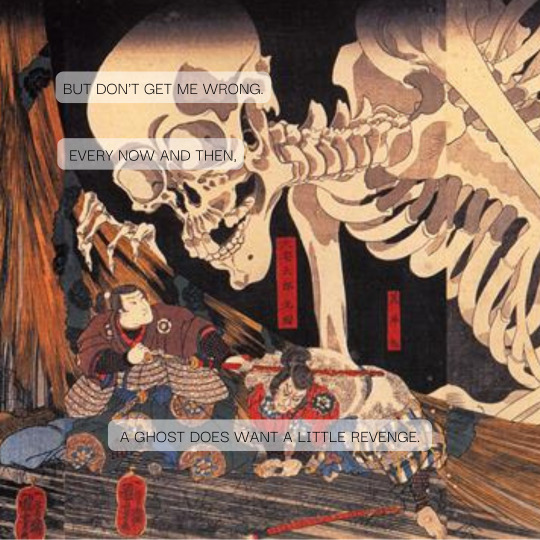
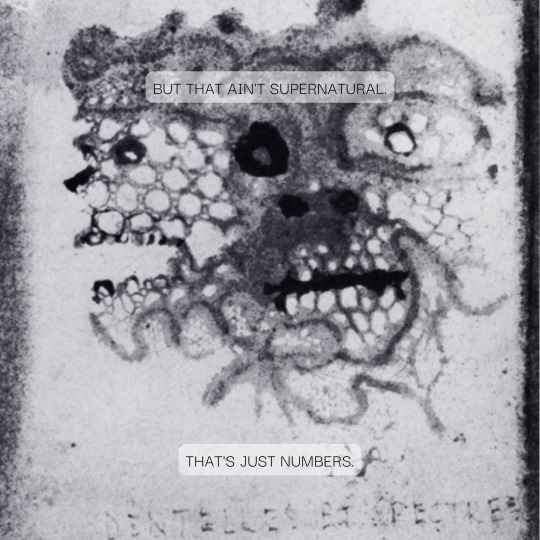
Happy Ten Year Anniversary Friends At the Table!
Moonrise in ghosts - Jean Dubuffet | Camille Monet On Her Deathbed - Claude Monet |Ghosts of UFA - Richard Hamilton | Orfeova Smrt - Emil Filla | Ghost Dance (The Vision of Life) - Ralph Blakelock | Introduction. Picture from the magazine Vampire - Boris Kustodiev | Death Knight - Salvador Dali | Death of the Striker - Vasile Dobrian | Mitsukuni Defying the Skeleton Spectre Invoked by Princess Takiyasha - Utagawa Kuniyoshi | Lace and Ghosts - Victor Hugo
111 notes
·
View notes
Text
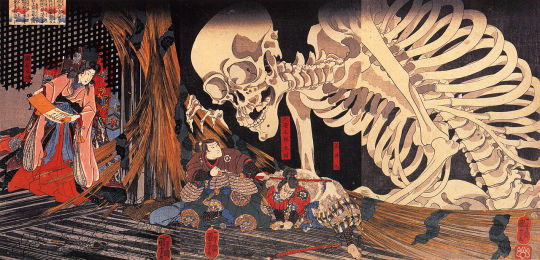
Mitsukuni Defying the Skeleton Spectre Invoked by Princess Takiyasha, by Kawase Hasui, ca. 1845
https://www.masterpiece-of-japanese-culture.com/paintings/utagawa-kuniyoshi-skeleton-print-work
#ukiyoe#japanese art#japanese prints#woodblock printing#japanese woodblock#woodblock print#woodblock art
72 notes
·
View notes
Text
SET SEVEN - ROUND ONE - MATCH FIVE
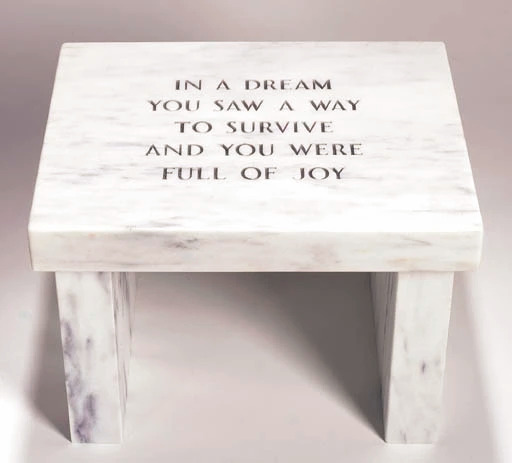

"Survival Series: "In a Dream You Saw a Way"" (1998 - Jenny Holzer) / ""Takiyasha the Witch and the Skeleton Spectre" 相馬の古内裏 妖怪がしゃどくろと戦う大宅太郎光圀 or Mitsukuni Defying the Skeleton Spectre Invoked by Princess Takiyasha" (c.1844 - Utagawa Kuniyoshi 歌川 国芳)
SURVIVAL SERIES: IN A DREAM YOU SAW A WAY: [no additional commentary] (anonymous)
TAKIYASHA THE WITCH AND THE SKELETON SPECTRE: [no additional commentary] (your mod team)
("Survival Series" is a series of works by American artist Jenny Holzer, which consists of texts written on different objects. This bench, "In a Dream You Saw a Way to Survive and You Were Full of Joy", is made of white marble and measures 17 x 24 x 17 in. (43.2 x 61 x 43.2 cm.)
"Takiyasha the Witch and the Skeleton Spectre" 相馬の古内裏 妖怪がしゃどくろと戦う大宅太郎光圀 or Mitsukuni Defying the Skeleton Spectre Invoked by Princess Takiyasha" is a woodblock print and triptych by Utagawa Kuniyoshi. Copies of this print are held in the Victoria and Albert Museum, London, and Honolulu Museum of Art.)
#sorry for no commentary on this one#a little boring but great pieces otherwise#art that fucks you up tournament#polls#atfyu polls#id in alt text
53 notes
·
View notes
Note
Eito 🖤
🐉 DRAGON — what is your oc's favorite mythical creature?
<3
DRAGON: there are some that he likes in particular, but his favorite one is probably the Gashadokuro. He finds the concept behind it pretty fascinating: the fact that is a mix of bones raising from the deceased (almost unionizing against the living), that they are pretty vengeful, and that they hunt people in the dead of night making bone-chilling sounds with glowing eyes. While the most famous rapresentation of it is in "Mitsukuni Defying the Skeleton Spectre Invoked by Princess Takiyasha" by Utagawa Kuniyoshi, there's another illustration that Eito likes a bit more: the one by Shigeru Mizuki.
2 notes
·
View notes
Text

Utagawa Kuniyoshi, Mitsukuni Defying the Skeleton Spectre Invoked by Princess Takiyasha
0 notes
Photo

Takiyasha the Witch and the Skeleton Spectre, (c.1844) by Utagawa Kuniyoshi (1798-1861)
#art#japanese#utagawa kuniyoshi#takiyasha the witch and the skeleton spectre#mitsukuni defying the skeleton spectre invoked by princess takiyasha#japanese mythology#mythology#monsters#people#men#women#19th century#1800s#early 1800s#ukiyo-e#woodblock#triptych#honolulu musem of art
84 notes
·
View notes
Photo

Mitsukuni Defying the Skeleton Spectre Invoked by Princess Takiyasha (1845). Utagawa Kuniyoshi.
113 notes
·
View notes
Photo




Utagawa Kuniyoshi - Princess Takiyasha, the Witch and the Skeleton Spectre (Mitsukuni Defying the Skeleton Spectre Invoked by Princess Takiyasha), blockprint triptych, ca. 1844.
98 notes
·
View notes
Photo

Trying to draw Kuniyoshi’s Ukiyoe.
相馬の古内裏 - 歌川国芳
Triptych of Takiyasha the Witch and the Skeleton Spectre
Kuniyoshi Utagawa
Takiyasha the Witch and the Skeleton Spectre or Mitsukuni Defying the Skeleton Spectre Invoked by Princess Takiyasha is a ukiyo-e woodblock triptych by Japanese artist Utagawa Kuniyoshi.
#doodling#doodle#drawing#triptych of takiyasha the witch and the skeleton spectre#utagawa kuniyoshi#歌川国芳#相馬の古内裏#浮世絵#ukiyoe#Japanese ukiyoe#obon#お盆#bun suzuki#art#Japanese art#yokai#takiyashahime
4 notes
·
View notes
Photo

Mitsukuni defying the skeleton spectre invoked by Princess Takiyasha
歌川国芳 (Utagawa Kuniyoshi, 1798 - 1861)
相馬の古内裏 妖怪がしゃどくろと戦う大宅太郎光圀
This print illustrates the Princess Takiyasha, a sorceress who can make ghosts appear.
wikipedja
5 notes
·
View notes
Text
Oh heck yes! Looks like an incredible museum visit!
I saw this one in person when I lived in Japan in 2011, but it really left an impression on me. One of my faves of all time:
Mitsukuni Defying the Skeleton Spectre Invoked by Princess Takiyasha, Utagawa Kuniyoshi (c. 1844)


Saw an amazing exhibition yesterday called Japan Supernatural. Got to see Toriyama Sekien’s ‘Night Procession of the Hundred Demons’ up close, along with some of my favourite ukiyo-e wood block prints.

Also some truly creepy photographs from Miwa Yanagi’s Fairy tale series.


Two giant oni figures by Takahashi Murakami took up an entire room.


But my favourite artwork? I lost my heart to this little dude...

A teeny tiny oni netsuke. He seems to be chanting a prayer while he bangs on a drum, but he sure doesn’t look happy about it! Bang on tiny oni, you do you buddy.
27 notes
·
View notes
Text

Mitsukuni Defying the Skeleton Spectre Invoked by Princess Takiyasha, by Utagawa Kuniyoshi, 19th century
#ukiyoe#japanese art#japanese prints#woodblock printing#japanese woodblock#ukiyo-e#woodblock print#woodblock art
21 notes
·
View notes
Photo

Takiyasha the Witch and the Skeleton Spectre or Mitsukuni Defying the Skeleton Spectre Invoked by Princess Takiyasha is an ukiyo-e woodblock triptych by Japanese artist Utagawa Kuniyoshi (1798–1861). Kuniyoshi was known for his depictions of historical and mythical scenes, and combined both in portraying the tenth-century princess Takiyasha summoning a skeleton spectre to frighten Ōya no Mitsukuni. In the image, the princess recites a spell written on a handscroll, summoning a giant skeleton. It rears out of a black void, crashing its way through the tattered palace blinds with its bony fingers to menace Mitsukuni and his companion. The historical Princess Takiyasha was the daughter of the provincial warlord Taira no Masakado, who tried to set up an "Eastern Court" in Shimōsa Province in competition with the emperor in Heian-kyō (modern Kyoto). Masakado's rebellion was put down in the year 939 and he was killed. After his death, Princess Takiyasha continued living in the ruined palace of Sōma. The artwork shows a mythical episode in which the emperor's official, Mitsukuni, comes to search for surviving conspirators. A copy of this print is currently housed in the Honolulu Museum of Art having been donated by its previous owner, Victor S. K. Houston in 1941. #destroytheday
0 notes
Photo


Utagawa Kuniyoshi - Takiyasha the Witch and the Skeleton Spectre or Mitsukuni Defying the Skeleton Spectre Invoked by Princess Takiyasha 1843-47 - Color woodblock print Technique: Nishiki-e. The gif is by Kevin Hong.
0 notes
Text
Romanticism (1730-1860) and the Edo Period of Japan (1603-1868)
When Europe went from the Enlightenment to Romanticism, Japan was in its Edo period. While Romanticism turned against the rationality of the Enlightenment, and stressed free expression of emotions, imagination and individualism, the Edo period of Japan embraced rationality and the individual’s sense of duty to the society, rather than its own emotions. We wish to examine the possible reasons for these differences here.
Romanticism entails a “cultural shift” from the Enlightenment; an artistic – but also intellectual – and philosophical movement. This movement expressed disappointment in industrialization and division of labor and was, in a way, a reaction to the rational, mechanical and utilitarian Enlightenment. Instead, romanticists turned to nature and the idea of an undivided world of infinity (van Poecke, 2017). Philosopher Friedrich Schiller expressed it as “beauty being the way to morality and freedom” (Beiser, 2005; van Poecke, 2017). Romanticism put its focus on human freedom and expressing feelings about the world through creation, as seen through its art. It supported l’art pour l’art; art did not aim to reproduce reality but was its own reality (van Poecke, 2017). Many artworks of that period were poetic and metaphorical, depicting nature and considering life and death – the finite and the infinite.

1. Fishermen at Sea (1794) by William Turner

2. The Abbey in the Oakwood (1809-1810) by Caspar David Friedrich
Before Tokugawa Iyeasu seized power in 1603 and established Tokugawa Shogunate (1603-1868), Japan had to go through very turbulent and uneasy times of civil strife and petty tyranny of daimyos – or feudal lords. Nevertheless, during that time and for first few years of Edo period Japan was gladly hosting a big variety of outsiders – gaikokujins: merchants, men of science, diplomats and even Jesuits from Spain, Portugal, The Netherlands and so forth. However, Japan gradually had become an isolated country with its own new foreign policy that was called Sakoku, stating that henceforth only a small number of Japanese merchants and interpreters were allowed to contact with outsiders, and that only could happen on an artificially built island of Dejima near Nagasaki. The only European country that was still allowed to make deals with was The Netherlands (Hall, 1988, pp. 369-371).
With almost no opportunity to communicate with the outside world, Japanese artists of Edo period had to develop the art on their own, thus without any chance to find inspiration or be influenced by other culture’s arts. Although Japan was studying rangaku, or “Dutch studies”, books and works that included sciences and art techniques that Japanese merchants were able to purchase from Dutch sailors, those of few art pieces and books that managed to come through all the barriers to common people were mostly studied for the academic purposes, rather than for aesthetics.
The major intellectual movement of Edo period was Neo-Confucianism, the original ideas of that came into Japan from country’s main trade partner – China. Thus, unlike emphasis on emotions and individualism, that was inherent in Romanticism movement that was overwhelming Europe back at that time (except for the Netherlands), Japan of the Edo period absorbed the ideas of rationalism, humanism, diligence, honor and giri – individual’ sense of duty to the society (Blocker et. al., 2001, p. 64).
The major art genre (perhaps, the only one existing back at that time) was Ukiyo-e, or “the pictures of the floating world”. The artist was making a print, or, less frequently, painting on a wooden block. At first, the main objects that artists were depicting were geishas or kabuki theatre actors. However, as more and more rich people were interested in purchasing these art pieces to decorate their homes, the number of depicted objects had expanded to landscapes, fauna and mythology.
Instead of drawing conclusions, we could perhaps reflect over whether the fundamental differences between the intellectual and artistic development of Romanticism and the Edo period had to do with the isolationist foreign policy of Japan of the time or not. We could consider the fact that the only European influences Japan had during the Edo period was through the trade with the Netherlands, the one European country who did not go through a Romanticist movement, and Japan did not put a focus on studying the aesthetics of Dutch art anyhow, but only studied the art for academic purposes.
The transformation of Ukiyo-e themes can be seen below:

3. Comb (1798) by Kitagawa Utamaro

4. Hare and Dandelion (1820) by Kubo Shunman.

5. Mitsukuni Defying the Skeleton Spectre Invoked by Princess Takiyasha (1844) by Utagawa Kuniyoshi.
By:
Rashevskiy Renat, 409152
Salomonsson Lovisa, 411971
References
Beiser, F., & Oxford University Press. (2005). Schiller as Philosopher: A Re-Examination. Oxford, NY: Oxford University Press.
Blocker, H. G., & Starling, C. L. (2001). Japanese philosophy. Albany, NY: State University of New York Press.
Hall, J. W. (1988). The Cambridge history of Japan. Cambridge: Cambridge University Press.
Van Poecke, N. (2017). Schiller and the Romantics: “Changing the world into a work of art”. Lecture, Erasmus University Rotterdam.
0 notes